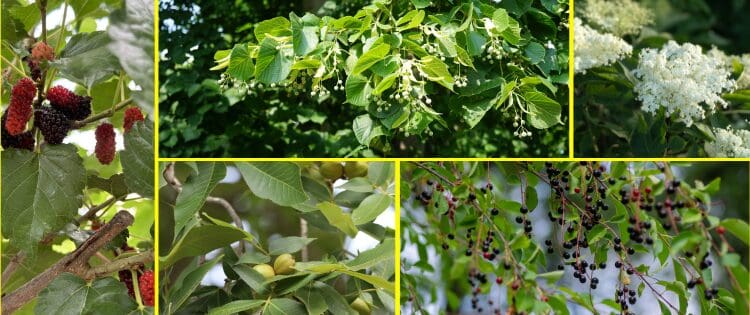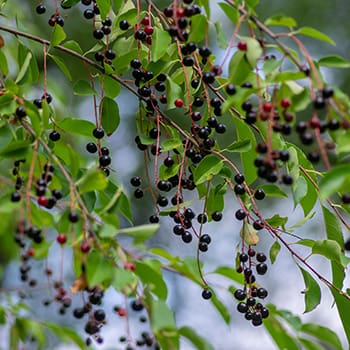In the age of convenience and mass-produced food, foraging is a great way to broaden your selection of healthy ingredients outside of what’s grown on your land. Foraging allows homesteaders to diversify their meals by adding new textures, flavors, and nutritional properties.
Foraging tree leaves has become an important part of my independent lifestyle, where I appreciate the simplicity of nature and the joy of providing for myself using what the land provides. Here are eight edible leaves to forage this summer.
Elder (Simbucus Nigra)
Elder is a flowering small tree from the Caprifoilaceae family. It originates from Europe and North America and was traditionally used to treat colds and influenza-like conditions. According to folk medicine, elderberry is known as one of the world’s most powerful healing plants. It is packed with vitamins and antioxidants that help reduce inflammation, boost the immune system, and protect the heart. Elderberry is used for the treatment of conditions such as headaches, kidney problems, minor skin abnormalities, and joint pain.
Elderberry Oil Recipe
- Sterilize a large glass jar.
- Chop up a handful of dried elderberry leaves and add them to the jar.
- Fill the jar with almond oil (the leaves should be completely submerged) and cover.
- Let it sit for 4 weeks to macerate.
- Keep checking to ensure the leaves are completely covered, add more oil if required.
- After 4 weeks, strain the oil using a cheesecloth and store it in a cool dry place.
Mulberry Tree
Mulberry trees (Morus spp.) can be found throughout North America, particularly in regions with temperate climates. They are commonly found in parks, along roadsides, and in open woodlands. To forage their leaves, look for mature trees during the summer months. Harvest the young, tender leaves, avoiding older ones.
One delicious recipe utilizing mulberry leaves is mulberry leaf tea. Steep a handful of fresh or dried leaves in boiling water for 5-10 minutes. Sweeten if desired and enjoy the mild, earthy flavor.
In traditional medicine, mulberry leaves have been used for their potential anti-diabetic and cholesterol-lowering properties. Consult a healthcare professional for appropriate usage and dosage.
Lime (Tila Cordata)
Lime leaves are found on the deciduous tree. The tree grows more than 20m tall and its bark is smooth and greyish-brown in color. Lime leaves are small (3-8cm in length) and heart-shaped; they are hairless with reddish-brown tufts underneath the vein joints. They are not to be confused with common lime (tilia x europaea) which have tufts of white hairs between the vein joints. Or large-leaved lime (tilia platyphyllos) which have hairs all over the underside. Lime leaves are best in salad, but they can also be made into lime tea which is an effective treatment to lower blood pressure, and prevent hardening of the arteries.
Lime Tea Recipe
- Add 8 ounces of water to a small pot and bring to a boil over a high temperature.
- Add 2-4 tablespoons of dried lime leaves to a mug.
- Pour the hot water over the leaves and leave it to steep for 15 minutes.
- Use a strainer to pour the tea into another mug, and drink.
Hickory Tree
Hickory trees (Carya spp.) are native to North America and can be found in various regions, particularly in deciduous forests and wooded areas. Look for their distinctive compound leaves and hard, spherical nuts during late summer and early fall. While hickory leaves are not commonly foraged, the young, tender leaves can be gathered in spring and used in salads or as a flavorful addition to cooked dishes.
Medicinally, hickory leaves have been used traditionally for their antimicrobial and anti-inflammatory properties. However, it is important to consult a healthcare professional before using them for medicinal purposes due to potential variations in potency and safety.
Maple Tree
Maple trees (Acer spp.) are widespread in North America, especially in temperate regions with rich soil.
To forage their leaves, look for mature maples in spring and early summer, selecting young, fresh leaves. These leaves can be used in salads, as tea, or steeped in hot water to create a maple-infused beverage.
Medicinally, some indigenous communities have used maple leaves for their potential anti-inflammatory properties.
In homesteading, maple leaves can be composted to enrich the soil or used as a natural mulch to retain moisture and suppress weeds, promoting a sustainable gardening practice.
Basswood Tree
Basswood trees (Tilia spp.) thrive in North America’s temperate forests and woodlands.
To forage their leaves, seek young, vibrant leaves in late spring and early summer. Basswood leaves can be used in salads or as wraps for stuffing, imparting a subtle, citrusy flavor.
Medicinally, the flowers and leaves are known for their potential to soothe respiratory issues and promote relaxation.
In homesteading, basswood is prized for its lightweight, softwood, ideal for carving and crafting, while its fibrous inner bark can be used for making cordage or baskets.
Elm Tree
Elm trees (Ulmus spp.) are common in North America, often found in moist forests, along riverbanks, and in urban areas.
To forage their leaves, search for young, tender leaves in late spring or early summer. Elm leaves can be used in salads or sautéed as a nutritious green vegetable.
Medicinally, some indigenous cultures used elm leaves for their potential anti-inflammatory properties to soothe sore throats and skin irritations.
In homesteading, elm wood has been used for furniture, while the bark can be employed for baskets or as a natural fiber source for cordage. However, beware of Dutch elm disease, which has devastated many elm populations.
Hackberry Tree
Hackberry trees (Celtis spp.) are commonly found in various habitats across North America, including woodlands, riverbanks, and urban areas.
To forage their leaves, look for young, fresh leaves in the spring and early summer. Hackberry leaves can be used in salads or as a leafy green in cooked dishes.
In traditional medicine, some indigenous communities have used hackberry leaves for their potential as a diuretic and to alleviate sore throats. In homesteading, hackberry wood has been used for various crafts and small woodworking projects due to its durability and ease of working with.
Final Thoughts
After years of gathering tree leaves as a homesteader, I’ve learned important things about foraging. It has shown me how nature is full of valuable resources. I’ve learned to notice the different seasons and recognize which leaves are safe to eat. Foraging has expanded my cooking skills and introduced me to new flavors.
I’ve also discovered that some leaves have healing properties, which can be used as natural remedies. Most importantly, foraging has made me appreciate and feel more connected to the land.
You may also like:
The Forager’s Guide To Wild Foods: Book Review
How To Make Bark Bread From A Tree That Grows On Almost Every Street In America (Video)
Mosquito and Fly Repellent Plants You Need To Grow For Summer












